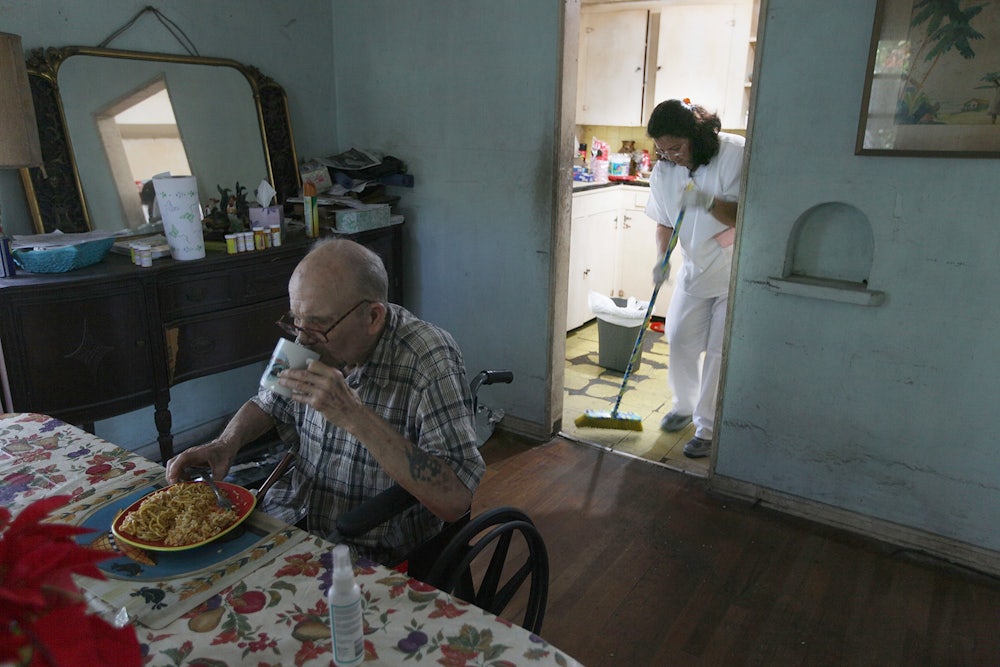More than a year into Donald Trump’s presidency, political commentators continue, despite all evidence to the contrary, to depict his political base as the “white working class.” Articles on his supporters seem almost entirely devoted to baseball-capped Middle Americans in declining industrial towns who believed the president’s campaign-trail promises to bring back coal, or steel, or keep the Carrier plant jobs in the country.
There are problems with this image of the U.S. factory worker as he—and it is generally he—is depicted. First, in American factories, the workforce is far more diverse than the Rust Belt narrative would have it. The Carrier plant, site of Trump’s triumphant deal that, in fact, resulted in hundreds of workers still being laid off, had at least as many African American workers as white, and there were plenty of women laboring there, too. More important, those industrial workers who supposedly put Trump in office (a dubious assumption) have never made up the entirety of the working class or even its majority. These days, only around 11 percent of the working class are white men in industrial jobs.
Although the “narrative makers” may have missed it, the working class has changed. Those who used to occupy its fringes—hotel housekeepers, retail clerks, and home care aides—are now its majority. Today, home health care is the fastest-growing industry in the United States, projected to add over a million new jobs to the economy in the next ten years. Retail jobs, according to the Bureau of Labor Statistics, currently make up 10 percent of all employment.
These jobs have always been important, but as automation and outsourcing have decimated manufacturing, the relative significance of service work has increased. Manufacturing employment peaked in 1953, at around 30 percent of jobs; now it is the service industry that dominates. An earlier era of political thought dismissed these workers politically, and that thinking still holds in many quarters: In the Supreme Court’s 2014 Harris v. Quinn decision, Justice Samuel Alito deemed home care workers only “partial” employees, a separate category of worker altogether.
Service workers have, of course, been in unions for many years. Their presence has in fact fueled what little growth unions have seen of late. But workers have also found effective ways to pursue their interests outside of the old union model. In one telling example, Hardee’s and Carl’s Jr. workers were able to force Andy Puzder, the unpopular former CEO of the two chains, who has faced allegations of sexual harassment and abuse, against his company as well as him personally, to withdraw his nomination for Secretary of Labor.
This change in the composition of the workforce has the potential to redefine traditional alliances in the United States. Already, unconventional partnerships have formed across different groups: Walmart workers, restaurant workers, and domestic workers have organized and joined with community groups and movements such as Occupy Wall Street and the Movement for Black Lives. These alliances also take into account the importance of unpredictable scheduling, social isolation, safety concerns, and gendered and racialized expectations of who is “naturally” inclined to service work.
One continuing political problem for the working class is that it remains difficult to measure it properly. Most estimates rely on flawed data. As Tamara Draut noted in her book Sleeping Giant, political surveys rarely capture occupational data, and many researchers still use education as a defining characteristic of class and a proxy for increased income. That no longer makes sense in a country in which average earnings for adjunct professors, who often have Ph.D.s, run around $20,000 per year, the same as for a home health care worker. But pollsters have yet to adjust—and politicians still listen to them.
Beyond the flawed data, the real issue is whether either of the two U.S. political parties has any interest in advancing the goals and needs of the working class as it actually exists. Trump’s political persona—or at least those aspects of it unrelated to self-aggrandizement, naked cash grabs, or global belligerence—was built on the idea that he could turn the GOP, as banished Trump-guru Steve Bannon put it, into a “worker’s party.” But the workers he purported to speak for—the white, male ones—were just a fraction of the entire working class, and while their problems are real, they continue to receive outsize attention. Meanwhile, there has been some movement since the election away from a purely corporate Democratic Party—advocacy for the $15 minimum wage laws, paid sick leave, and new enthusiasm for single-payer health care—but right now, despite everything, the working class and its discontents still largely fall outside the two parties we have.
To understand the U.S. electorate in 2018 and beyond requires a new understanding of the working class as a shifting, re-forming entity with distinct political demands—demands that present opportunities that have nothing to do with Trumpian economic anxiety or nostalgia for a long-gone economic mythology.
